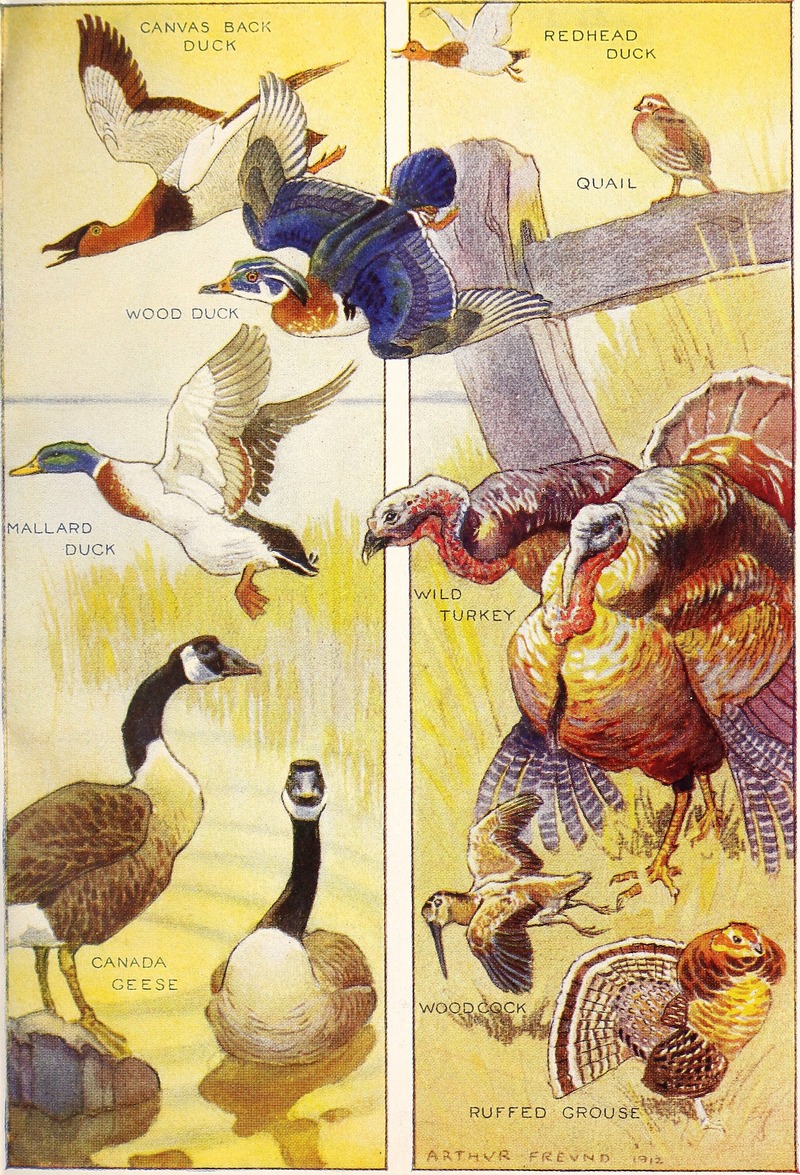|
| 질의: large white | 결과: 1262번째/2106 | |
canvasback duck (Aythya valisineria), redhead (Aythya americana), Carolina duck (Aix sponsa), quail, mallard / wild duck (Anas platyrhynchos), wild turkey (Meleagris gallopavo), Canada goose (Branta canadensis), American woodcock (Scolopax minor), ruffed grouse (Bonasa umbellus)
| 제목: | canvasback duck (Aythya valisineria), redhead (Aythya americana), Carolina duck (Aix sponsa), quail, mallard / wild duck (Anas platyrhynchos), wild turkey (Meleagris gallopavo), Canada goose (Branta canadensis), American woodcock (Scolopax minor), ruffed grouse (Bonasa umbellus)
| | 올린이: | Wiki Photos (---@---.---)
| |

| 해상도: 2220x3260
파일크기: 3517743 Bytes
등록시간: 2017:07:30 14:41:49
|
COPYRIGHT, 1912, BY F. K. WRIGHT.
CANADA GAME BIRDS
- Canvas Back Duck = canvasback duck (Aythya valisineria)
- Redhead Duck = redhead (Aythya americana)
- Wood Duck = Carolina duck (Aix sponsa)
- Quail
- Mallard Duck = mallard / wild duck (Anas platyrhynchos)
- Wild Turkey = wild turkey (Meleagris gallopavo)
- Canada Goose = Canada goose (Branta canadensis)
- Woodcock = American woodcock (Scolopax minor)
- Ruffed Grouse = ruffed grouse (Bonasa umbellus)
Title: Webster's home, school and office dictionary
Year: 1916 (1910s)
Authors: Noah Webster, 1758-1843; Robert Arrowsmith, 1860- ; Harry Thurston Peck, 1856-1914, ed
Subjects: English language
Source book page: https://archive.org/stream/webstershomescho00web/webstershomescho00web#page/n20/mode/1up
Source: https://commons.wikimedia.org/wiki/File:Webster%27s_home,_school_and_office_dictionary_(1916)_(14777323102).jpg
The canvasback duck or canvasback (Aythya valisineria) is a species of diving duck, the largest found in North America.
The redhead duck or redhead (Aythya americana) is a medium-sized diving duck. During breeding season, redheads are found across a wide range of North America, from as far north as Northern Canada to the lower United States.
The wood duck or Carolina duck (Aix sponsa) is a species of perching duck found in North America. It is one of the most colorful North American waterfowl.
Quail (?)
The mallard or wild duck (Anas platyrhynchos) is a dabbling duck that breeds throughout the temperate and subtropical Americas, Eurasia, and North Africa
The wild turkey (Meleagris gallopavo) is an upland ground bird native to North America and is the heaviest member of the diverse Galliformes. It is the same species as the domestic turkey.
The Canada goose (Branta canadensis) is a large wild goose species with a black head and neck, white patches on the face, and a brown body. Native to arctic and temperate regions of North America, the migration of Canada geese occasionally reaches northern Europe.
The American woodcock (Scolopax minor), sometimes colloquially referred to as the timberdoodle, is a small chunky shorebird species found primarily in the eastern half of North America.
The ruffed grouse (Bonasa umbellus) is a medium-sized grouse occurring in forests from the Appalachian Mountains across Canada to Alaska. It is non-migratory. It is the only species in the genus Bonasa. |
^o^
동물그림창고 똑똑전화 누리집
^o^
|
|